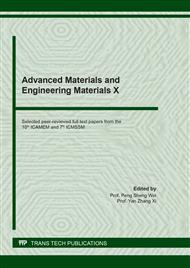[1]
H. Li, L. Dong, Z. Jiang, X. Yang, and Z. Yang, Study on utilization of red brick waste powder in the production of cement-based red decorative plaster for walls,, J. Clean. Prod., vol. 133, p.1017–1026, 2016,.
DOI: 10.1016/j.jclepro.2016.05.149
Google Scholar
[2]
U.S. Enviromental Protection Agency Office of Resource Conservation and Recovery, Construction and Demolition Debris Management in the United States , 2015,, no. March, p.1–24, (2020).
Google Scholar
[3]
C. L. Wong, K. H. Mo, S. P. Yap, U. J. Alengaram, and T. C. Ling, Potential use of brick waste as alternate concrete-making materials: A review,, J. Clean. Prod., vol. 195, p.226–239, 2018,.
DOI: 10.1016/j.jclepro.2018.05.193
Google Scholar
[4]
A. Zúñiga, Ciencia e ingeniería de nuevos materiales en la fabricación mejorados tecnologicamente,, Universidad Politécnica de Madrid, (2018).
DOI: 10.20868/upm.thesis.52643
Google Scholar
[5]
J. Davidovits, Geopolymer and Applications. France: Institut Geopolymere, (2015).
Google Scholar
[6]
ASTM D422, Standard Test Method for Particle-Size Analysis of Soils,, Annu. B. ASTM Stand., vol. D422-63, p.1–8, 2007, doi: West Conshohocken, PA.
Google Scholar
[7]
ASTM D4318, Standard Test Methods for Liquid Limit, Plastic Limit, and Plasticity Index of Soils,, Annual Book of ASTM Standards, 2017. https://www.astm.org/Standards/D4318.
Google Scholar
[8]
ASTM C373, Standard Test Method for Water Absorption, Bulk Density, Apparent Porosity, and Apparent Specific Gravity of Fired Whiteware Products,, Annu. B. ASTM Stand., vol. 88, no. Reapproved, p.1–2, 1999,.
DOI: 10.1520/c0373-14
Google Scholar
[9]
A. H. Munsell, Munsell soil color charts. Baltimore, (1990).
Google Scholar
[10]
B. Lesikar, C. Hallmark, R. Melton, and B. Harris, On-Site Wastewater Treatment Systems: Soil Particle Analysis Procedure,, Texas A&M Univ. Syst., p.18, 2005, [Online]. Available: http://nctx-water.tamu.edu/media/1602/b-6175.pdf.
Google Scholar
[11]
NRCS Soils Staff, Soil Survey Manual. Washington, (1951).
Google Scholar
[12]
V. J. García, C. O. Márquez, A. R. Zúñiga-Suárez, B. C. Zuñiga-Torres, and L. J. Villalta-Granda, Brazilian Test of Concrete Specimens Subjected to Different Loading Geometries: Review and New Insights,, Int. J. Concr. Struct. Mater., vol. 11, no. 2, p.343–363, 2017,.
DOI: 10.1007/s40069-017-0194-7
Google Scholar
[13]
A. A. Griffits, The phenomena of rupture and flow in solids,, Philos. Trans. R. Soc., vol. A221, p.163–198, 1921,.
Google Scholar
[14]
N. INEN 297, Ladrillos cerámicos. Requisitos,, Inst. Ecuatoriano Norm., vol. 297, p.7, (1978).
Google Scholar
[15]
X. Hao, B. C. Ball, J. L. B. Culley, M. R. Carter, and G. W. Parkin, Chapter 57: Soil density and porosity,, Soil Sampl. methods Anal., no. June, p.743–760, (2006).
Google Scholar
[16]
B. Zúñiga-Torres et al., Innovative materials for sustainable construction,, Mater. Sci. Forum, vol. 1023 MSF, p.155–162, 2021,.
Google Scholar
[17]
O. S. Sore, A. Messan, E. Prud, G. Escadeillas, and F. Tsobnang, Synthesis and characterization of geopolymer binders based on local materials from Burkina Faso – Metakaolin and rice husk ash,, Constr. Build. Mater., vol. 124, p.301–311, 2016,.
DOI: 10.1016/j.conbuildmat.2016.07.102
Google Scholar
[18]
R. Gutiérrez-Moizant, M. Ramírez-Berasategui, S. Santos-Cuadros, and C. C. García-Fernández, A Novel Analytical Solution for the Brazilian Test with Loading Arcs,, Math. Probl. Eng., vol. 2020, no. c, 2020,.
DOI: 10.1155/2020/2935812
Google Scholar


